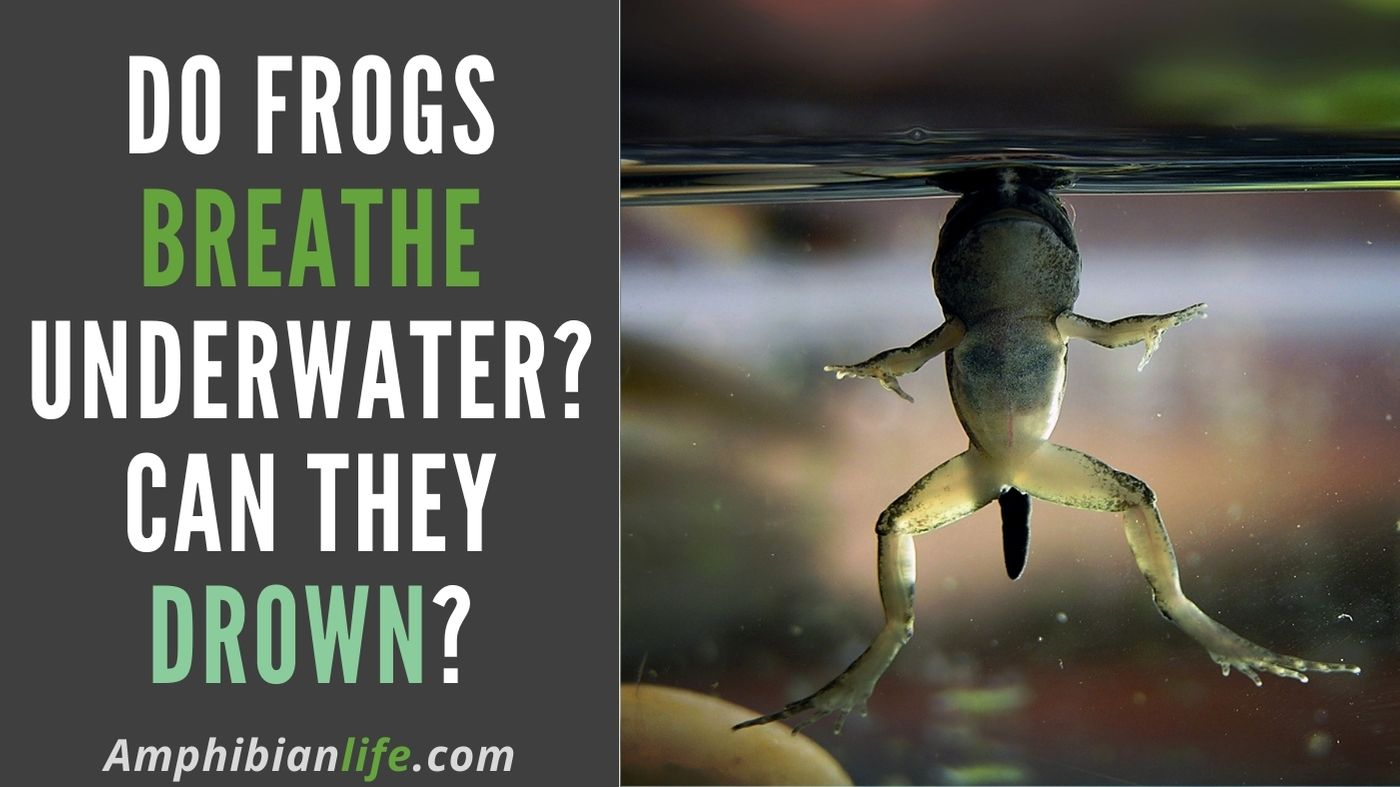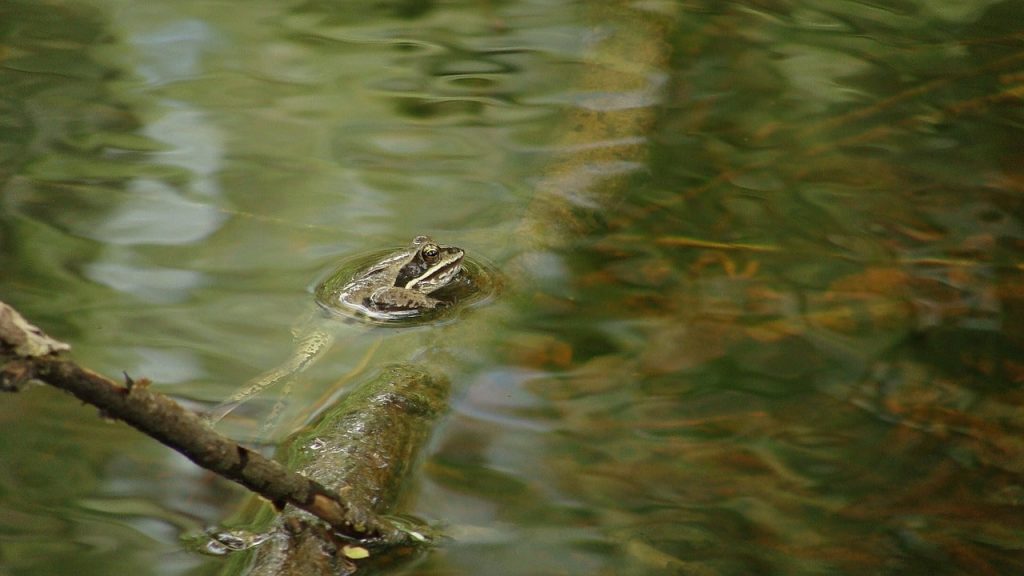
Yesterday I sat in my garden when I watched a frog swimming in my little pond. That’s when I asked myself if frogs could breathe underwater, and if so, how long for? And can they drown? I did my research and this is what I found.
So, can frogs breathe underwater? Yes, frogs can breathe underwater. They do this by absorbing oxygen through their skin. This means they can be in the water for a very long time.
Frogs can use this ability to avoid predators, for example.
Do All Frogs Live In Water? Does Frog Need Fresh Water?
Frogs are amphibians who live in both water and land. For example, toads and tree frogs spend the majority of their life outside water.
However, Bullfrogs and green frogs spend most of their time in the water.
Though no matter where they live, frogs will eventually come back to the water to mate and lay eggs.
Individuals who keep frogs at home must look after certain things. Make sure your frog tank has plenty of clean and fresh water.
You can use tap water, but it must be de-chlorinated or free much any added compounds/ harmful elements.
If you are doubtful about water quality, use appropriate de-chlorinators in your frog tank.
Frogs breathing underwater
Now let us dive (pun intended!) a little deeper into the matter…
As you’ll know from your knowledge of amphibians, all frogs go through a growing-up phase (also called metamorphosis) where they transition from water-based to land-based animals.
Frogs go from a larval stage to being a tadpole and eventually grow into adult frogs. In the early stage (as tadpoles) frogs have gills and can breathe underwater.
As they mature, frogs lose their gills but are still able to breathe. Instead of breathing through their gills, they start to breathe through their skin.
Importantly, this “skin breathing” can happen either on land (taking oxygen from the air) or underwater (taking oxygen from the water).

What happens exactly?
First, you need to know that frogs do have functional lungs. However, unlike humans, frogs don’t rely on their lungs as their only way of breathing. Most of their respiration actually occurs through their skin.
Frogskin is perfect for this because it is thin and marbled with blood vessels and capillaries that lie close to the surface.
The skin dissolves oxygen from the water or the air and transmits it into the blood.
When do frogs use their lungs?
Frogs only rely on their lungs to breathe when they are in action mode. In other words, when they need more oxygen than the skin can give.
When this isn’t necessary – for example, when the frog is sat resting – they use their skin to breathe.
If you compared frogs with other amphibians, you would notice that frogs have complex lungs that are better developed than other amphibians.
The lungs are subdivided and contain many alveoli (this is a general anatomical term for a concave cavity or pit).
As humans, we use our diaphragm to control our breathing. Frogs use their mouth and nostrils to control the airflow into their lungs.
When a frog breathes in, the lower portion of the mouth lowers and its throat relaxes.
Once its throat is relaxed, the frog opens its nostrils so that the air can flow into the mouth and the throat. The frog then contracts its mouth and forces the air into its lungs.
Can frogs drown?
Unfortunately, frogs can indeed drown.
You now know that frogs have lungs, just like humans do. And, also like humans, if their lungs fill with water, they can drown.
You might think: but frogs breathe through their skin, right? Yes, they can! But this depends on how much oxygen is in the water around them.
If the water is low in oxygen, the frog won’t be able to absorb enough to survive.
Which amphibians can also breathe underwater?
Now that you know that frogs can breathe underwater, you might find it interesting to know which other amphibians can do the same.
Some aquatic salamanders have gills and can breathe underwater. There are also aquatic salamanders, like the Mexican Axolotl, that never lose their gills!
All larvae can breathe underwater. It is only when they go through metamorphosis (e.g. from a tadpole to a frog) that some amphibian species lose the ability to breathe underwater.
Sea turtles still breathe air but normally only go on land when they have to lay eggs.
Not all amphibians can breathe underwater. With some amphibians, it appears that they can breathe underwater, when in fact they are holding their breath! Some amphibians can hold their breath for hours.
Fun fact: There are lungless salamanders that have neither lungs nor gills… They just breathe through their skin!
How long can frogs breathe underwater?
Frogs are amphibians and not fully aquatic animals they still breathe through their skin,
An adult frog can typically hold its breath anywhere between 4 to 7 hours.
Can frogs live completely underwater?
The short answer is both Yes and No. It depends on the frog’s life cycle and the growing stage they are in,
In the early juvenile tadpoles stage, they can live entirely underwater, like a fish. As they become adult frogs, they develop lungs and can breathe air through both lungs and perspiration through the skin.
Conclusion
By now I hope that you have learned a lot about frogs and the way they breathe.
We’ve learned that frogs can breathe underwater and that they do this by “inhaling” oxygen through their skin.
You have also learned that this is not the only respiration method they use. They can also breathe with their lungs, via their mouth and nostrils.
I hope you found it interesting to learn that frogs can in fact drown! At first, it may sound a little odd, but when you think about it… frogs have lungs, so yes, they can drown.
For Further Reading
I hope you enjoyed this article! If so, you may also find these articles interesting.
How high can frogs jump?
What do toads eat?
Why do frogs lay so many eggs?
